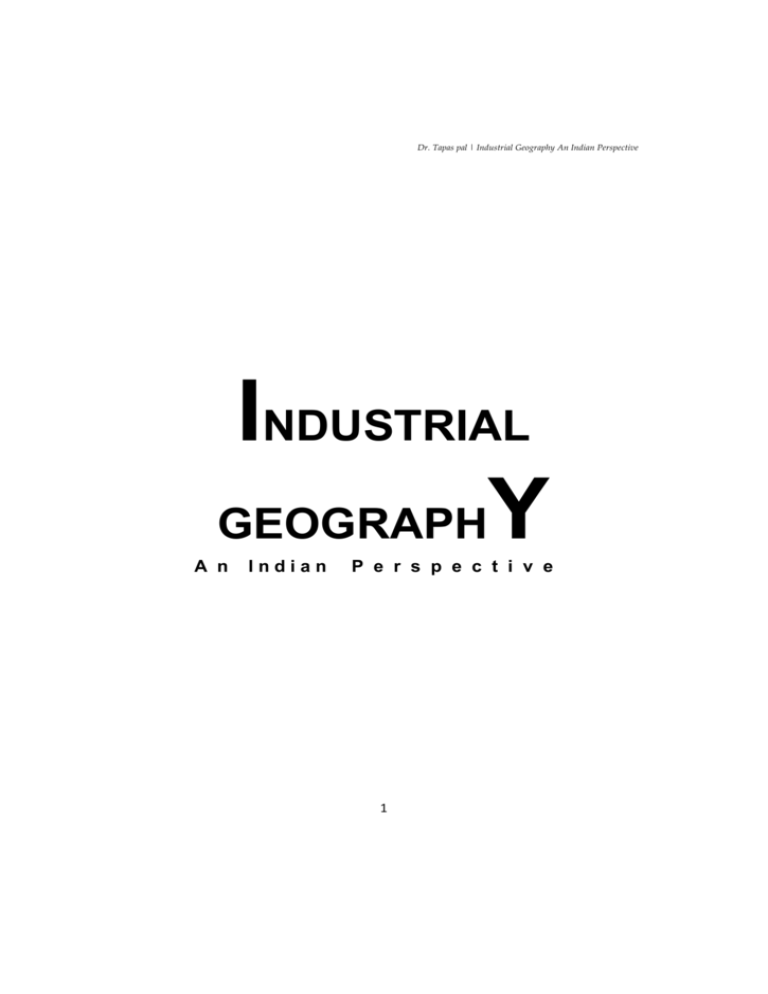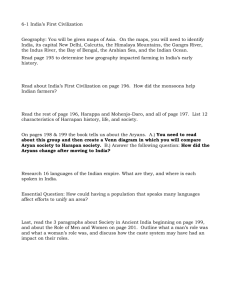
Dr. Tapas pal | Industrial Geography An Indian Perspective
INDUSTRIAL
GEOGRAPHY
A n
Indian
P e r s p e c t i v e
1
Dr. Tapas pal | Industrial Geography An Indian Perspective
INDUSTRIAL GEOGRAPHY
An Indian Perspective
Total pages: 242
© Tapas Pal, 2015
BRIDGE CENTER
Buzau, Al. Marghiloman 245 bis, 120082
Tel. 0728394546
e-mail: editor@euacademic.org
Romania, European Union
Printed in Romania
First published, 2015
Price € 20
All rights reserved. No part of this publication may be
reproduced or transmitted, in any form or by any means,
without permission. Any person who does any
unauthorised act in relation to this publication may be
liable to criminal prosecution and civil claims for
damages.
The publishers have applied for copyright permission for
those pieces that need copyright clearance and due
acknowledgement will be made at the first opportunity.
The views and contents of this book are solely of the
author. The author of the book has taken all reasonable
care to ensure that the contents of the book do not violate
any existing copyright or other intellectual property
rights of any person in any manner whatsoever. In the
event the author has been unable to track any source and
if any copyright has been inadvertently infringed, please
notify the publisher in writing for corrective action.
Reader: Ecaterina Patrascu
Cover Design: @Bridge Center
Available at: www.euacademic.org
2
Dr. Tapas pal | Industrial Geography An Indian Perspective
Dr. Tapas Pal
INDUSTRIAL
GEOGRAPHY
A n
Indian
P e r s p e c t i v e
Bridge Center, 2015
Romania
3
Dr. Tapas pal | Industrial Geography An Indian Perspective
Acknowledgements
I
am gratifying to
Prof. Sumanta Mukherjee
and
Dr. Krishnendu Gupta,
Deptt. of Geography, VisvaBharati, Santiniketan because these two were
my Industrial Geography teachers during my University life.
4
Dr. Tapas pal | Industrial Geography An Indian Perspective
Dedicated to
Prof. Bijay S. Mipun
Deptt. Of Geography, NEHU, Shillong
and
Prof. Guruprasad Chattyapadhyay
Deptt. Of Geography, Visva-Bharati, Santiniketan
5
Dr. Tapas pal | Industrial Geography An Indian Perspective
Special thanks to
Prof. Mehadi Gharaklau, Deptt. of Geography, University of Teheran, Iran
Prof. Debasish Das, Deptt. of Geography, Visva-Bharati, Santiniketan
Prof. B.K. Sinha, BHU
Dr. Piyal Basu Roy, Deptt. Of Geography, Alipurduar College, NBU
Dr. Pradip kumar Chauhan, Deptt. Of Geography, Malda College,
University of Gour Banga
Mr. Mohan Kumar Das, Research Officer at SAARC Meteorological Research
Centre (SMRC), Dhaka
6
Dr. Tapas pal | Industrial Geography An Indian Perspective
Preface
In writing Industrial Geography, Dr. Tapas Pal has made an
extraordinary contribution to geographical scholarship.
The book
provides an overview of a very important subject area, reviewing a
broad range of nineteenth and twentieth century theories, models and
cases, and carrying the subject matter forward to the twenty-first
century
world
of
instantaneous
global
communication,
nanotechnology, outsourcing, air freight and bulk container transport.
Dr. Pal
successfully links global scholarship to Indian realities and case studies, creating a book
of broad general interest which can also be used as a text in Indian universities.
Dr. Pal is an exceptionally productive young scholar with a broad vision of human
geography, including social, cultural and economic processes. His work on economic
geography comes at a time when the old location theories of Von Thünen, Weber,
Christaller and Lösch have become outmoded, but when strategic location is still
immensely important for successful industrial and real estate development. Geography
has not been marginalized. Instead it has been revitalized and rediscovered, most
notably by distinguished economists like Paul Krugman, by new age business gurus like
Michael Porter, and by broad-ranging social scientists like SaskiaSassen and Manuel
Castells. “Location, location, location” has become a universal concern in the burgeoning
global real estate development industry, and business and academia have become
increasingly focused on the rapidly-changing network of “world cities”. The global rise of
East Asia has irrevocably changed the world’s industrial geography, and further
transformations are under way as India and other South and South-East Asian countries
rise to prominence.
Economic geography, and especially industrial and transportation geography, will
continue to change rapidly in the immediate future. Projects to expand the Panama and
Suez Canals, to open up overland and maritime “Silk Roads”, to build new international
oil and gas pipelines, to navigate the Arctic Ocean, and even to create a new inter-
7
Dr. Tapas pal | Industrial Geography An Indian Perspective
oceanic canal through Nicaragua, will bring major changes in international trade routes
and volumes.
Meanwhile, and in almost total contradiction to these techno-utopian
projects, there is a growing global consciousness of the unsustainability of current grandscale development, with increasing pressures caused by environmental contamination,
deforestation, soil erosion, urban sprawl, loss of biodiversity, and exhaustion of the
cheapest and most accessible groundwater, fossil fuel and mineral reserves.There is
more and more evidence of accelerating climate change associated with global warming,
increased storm, flood and drought hazards, and rising sea levels. Thus, our current
models of economic and industrial development are shown to be inadequate and new,
more sustainable models are desperately needed.
Tapas Pal’s Industrial Geography provides an excellent overview of the field, useful both
to students and to fellow researchers. His book illustrates the breadth of the subject area
and it will help inspire a new generation of scholars, policy-makers and business leaders.
Ray Bromley, PhD, AICP
Professor, Department of Geography and Planning
University at Albany, State University of New York, Albany, NY, June 2015
8
Dr. Tapas pal | Industrial Geography An Indian Perspective
Contents
Page no.
Chapter 1: INTRODUCTION
Industry and classification...............................................................................................................................14-17
Concept of Industrial Geography....................................................................................................................17-19
Social networks and industry..........................................................................................................17-19
History of industrial geography................................................................................................................ ........19-27
Industrial Culture regions.....................................................................................................................20
Core and periphery..............................................................................................................................20
Deindustrialization…………………………………………………………………………………................21
Global corporations..............................................................................................................................21
Emerge Tertiary industry…………………………………………………………………………………......21
Upcoming of Quaternary industry……………………………………………………………………….......22
Hong Kong (Central)………………………………………………………………………………................22
Emerged Quinary industry……………………………………………………………………………...........22
Diffusion of the Industrial Revolution....................................................................................................22
Life before the Industrial Revolution………………………………………………………....................….23
Cottage industry developed………………………………………………………………...........................23
Guild industry revolution………………………………………………………………................................23
Textiles formation………………………………………………………………………................ .........…..23
Start of Metallurgy…………………………………………………………………….. ...............................23
Mining industry formation……………………………………………………………….................. .....…..23
Rail and roads evolution………………………………………………………….......................................24
Industrial Diffusion from Britain……………………………………………………...............................24-27
Fundamental rationale....................................................................................................................................28-30
Imbalance in Indian industrial situation...........................................................................................................30-31
Industrialization and regional development.....................................................................................................31-33
Chapter 2: MANUFACTURING
Definition of manufacturing and its necessity.......................................................................................................35
Manufacturing as an economic activity................................................................................................................35
Meaning and Basic principle of manufacturing industrial.....................................................................................36
Data Generation..............................................................................................................................................36-37
Explanation of an industrial theory........................................................................................................37-38
Basic consideration of economic activity / manufacturing...............................................................................38-39
Factors of production...........................................................................................................................................39
Substitution..........................................................................................................................................................39
Basic quantitative techniques.........................................................................................................................40-.42
Equall outlay line..................................................................................................................................40-41
Equall product curve............................................................................................................................41-42
Line of scale / expansion path..................................................................................................................42
Chapter 3: MAJOR INPUTS IN INDUSTRY
Input structure and allied figure............................................................................................................................42
Land................................................................................................................................................................44-50
What are the requirements of land?..........................................................................................................44
Quality / land character / identity...............................................................................................................45
Economic consideration/identity................................................................................................................46
Land is a source of raw-material...............................................................................................................46
Perfect land...............................................................................................................................................47
Location of land.........................................................................................................................................48
Economic consideration............................................................................................................................48
How land, labour and capital are inter-related?.........................................................................................50
Capital..................................................................................................................................................................51
Function/ Requirement of capital...............................................................................................................51
What are the generation of capital?...........................................................................................................51
Sources of Capital.....................................................................................................................................51
9
Dr. Tapas pal | Industrial Geography An Indian Perspective
What are the factors for generation of Capital?....................................................................................51-52
Downstream industry.................................................................................................................................52
Industrial inertia....................................................................................................................................52-53
Labour..................................................................................................................................................................53
How does labour influence on the location of Industry?.......................................................................53-55
What are geographic or socio cultural factor influence of an industry?....................................................55
Skill ...........................................................................................................................................................55
Industrial profitability influenced by labour.......................................................................................... 55-56
Raw Materials................................................................................................................................................56-59
What is available and where it is available? .............................................................................................56
Examples of natural raw materials transportation.....................................................................................57
Raw material classification........................................................................................................................57
Assembly industry.....................................................................................................................................58
Ancillary (after the main) industry..............................................................................................................59
Power........................................................................................................................................................59
Enterprise.............................................................................................................................................................60
Lateral relationship…………………………………………………………………………………....….......60
Chapter 4: MARKET
Nature of market and factors................................................................................................................................62
Cost.................................................................................................................................................................62-63
How market can be identified and created?....................................................................................................... 63
What are the factors influences the role of advertisement?.................................................................................63
Geographical location of market...........................................................................................................................64
Human behavioural activity and market........................................................................................................64
Target group..................................................................................................................................................64
Typology of market..........................................................................................................................................65-66
Influencing factors of market...........................................................................................................................66-67
Elasticity of demand........................................................................................................................................67-68
Inelasticity of demands........................................................................................................................................68
Profitable question...............................................................................................................................................68
Profit determination curve.............................................................................................................................. 69-71
Industrial agglomeration (areal concentration / conglomeration / centripetal) and its factor...........................71-74
Industrial deglomeration.......................................................................................................................................75
Chapter 5: TRANSPORT
Transport is the Blueprint/ life line of an industry.................................................................................................77
Modes of transport...............................................................................................................................................77
How to minimize the transport cost?....................................................................................................................78
Freight rate...........................................................................................................................................................78
Postage stamp....................................................................................................................................................78
Blanket rate..........................................................................................................................................................78
Mileage rate....................................................................................................................................................79-80
Factors of Mileage rate.........................................................................................................................79-80
Carriage density variability...................................................................................................................................80
Telescopic Effect/Veblen effect...........................................................................................................................80
Combination of Blanket (Uniform) and mileage (variable)...................................................................................81
Terminal change..................................................................................................................................................81.
Line Haul Charge............................................................................................................................................... 81
Break of bulk point.............................................................................................................................................81
Static charge........................................................................................................................................................81
Move-cost..........................................................................................................................................................82
Backhaul change/ pendulum principle.................................................................................................................82
Break of bulk point / Transshipment Point......................................................................................................83-84
Advantages and Disadvantages of transportation modes...............................................................................84-85
Trucking Industry………………………………………………………………………………………………….......85-87
Factors those are responsible for trafficability of a region in terms of mode, efficiency and rate....................87-89
Isodopane line......................................................................................................................................................89
Ropeway............................................................................................................................................................. 90
10
Dr. Tapas pal | Industrial Geography An Indian Perspective
Chapter 6: THEORY, INDUSTRIAL REGION, INDUSTRIES
Theory in industrial geography.................................................................................................................... .........92
Conventional theory................................................................................................................................92-93
Radical theory.........................................................................................................................................93-94
Idiographic studies..................................................................................................................................94-95
Spatial organization................................................................................................................................95-97
Least cost theory of Alfred Weber (1909) – A Germany economist......................................................97-101
Why Durgapur iron and steel industry is present at Durgapur? .........................................................101-102
How iron and steel industry does initiates industrial agglomeration?.........................................................102
Bases of difference between Weber (German economy) and lose (German theoretical)..................102-103
Market area theory: Industrial location theory of Tord Palander (1935)..............................................103-107
August Losch (German theoretician)’s Market Area and Profit Maximization (1940) theory..............107-111
Industrial regions.........................................................................................................................................111-119
Demarcation of industrial region................................................................................................................112
Method of industrial region delineation......................................................................................................112
Industrial regions of India....................................................................................................................113-119
Industries....................................................................................................................................................119-198
Iron and steel industry......................................................................................................................119-127
Metallurgical Industries………………………………………………………………………..…………...128-129
Coal industry....................................................................................................................................129-131
Oil and gas industry……………………………………………………………………………………......131-133
Beverage industry............................................................................................................................133-138
Chemical industry.............................................................................................................................138-143
Petrochemical industry............................................................................................................................143
Dyestuffs industry……………………………………………………………………………………….............144
Fertilizer industry..............................................................................................................................144-147
Cotton textile industry/ apparel industry.......................................................................................... 148-154
Jute industry / the golden fiber.........................................................................................................155-160
Cottage industry………………………………………………………………………………………........160-161
Coir Industry............................................................................................................................................161
Handicraft Industry.......................................................................................................................... 161-162
Khadi industry……………………………………………………………………………………………....162-166
Sugarcane industry..........................................................................................................................166-171
Tourism industry...............................................................................................................................171-175
Sex industry......................................................................................................................................175-176
Film industry.....................................................................................................................................176-178
Truck framing...........................................................................................................................................178
Dairy farming Dyestuffs Industries..........................................................................................................178
Communication Industry..........................................................................................................................179
Electronics Industry......................................................................................................................... 180-181
Transport Equipment Industry……………………………………………………………………........... 181-182
Automobile Industry………………………………………………………………………………...………182-184
Vegetable Oil Industry.............................................................................................................................184
IT Industry……………………………………………………………………………………………….…..184-187
Paper Industry................................................................................................................................. 187-190
Plastics Industry………………………………………………………………………………………...…….…191
Drugs and Pharmaceutical industry…………………………………………………………………….……..192
Gems and jewelry industry……………………………………………………………………………......192-193
Defense industry………………………………………………………………………………………..…..194-195
Advertisement Industry…………………………………………………………………………...……….195-198
11
Dr. Tapas pal | Industrial Geography An Indian Perspective
CHAPTER 7: ENVIRONMENT AND INDUSTRY
Firm’s external environment........................................................................................................................200-201
The industry and challenger environment...................................................................................................201-202
Industrial ecology........................................................................................................................................202-204
Effect of industrialization.............................................................................................................................205-212
Positive.................................................................................................................................................205-206
Economy............................................................................................................................................205
Society...............................................................................................................................................205
Environment................................................................................................................................205-206
Negative.......................................................................................................................................................206
Economy............................................................................................................................................206
Society...............................................................................................................................................206
Environment.......................................................................................................................................206
Air emissions......................................................................................................................................207
Waste water.......................................................................................................................................207
River pollution…………………………………………………………………………………...........207-209
Land pollution....................................................................................................................................209
Marine and coastal pollution..............................................................................................................209
Hazardous materials.........................................................................................................................209
Solid waste.........................................................................................................................................210
Pesticides and pest control products.................................................................................................210
Asbestos and harmful dust.................................................................................................................210
Radiation............................................................................................................................................210
Noise..................................................................................................................................................210
Polluted industrial cluster identified by CPCB……………………………………………………...211-212
Strategy.......................................................................................................................................................212-215
SEZ and industrial park......................................................................................................................................216
Industrial town.............................................................................................................................................216-218
Chapter 8 RESEARCH DESIGNS, RECENT MODERN INDUSTRIES, RESEARCH DEVELOPMENT IN
INDUSTRIAL GEOGRAPHY
Research designs in industrial geography..................................................................................................219-221
Recent modern industries...........................................................................................................................221-229
Economic liberalization.......................................................................................................................221-222
Industrial self reliance................................................................................................................................222
Footwear manufacturing.....................................................................................................................222-223
Biotechnology industry...............................................................................................................................223
Nanotechnology industry....................................................................................................................223-226
Internet Industry..................................................................................................................................226-228
New Media..........................................................................................................................................228-229
Research Development in Industrial Geography........................................................................................229-233
IPR and Industry.........................................................................................................................................233-234
Prime Minister Narendra Modi and Industry of India……………………………………………………….…234-236
Global village.....................................................................................................................................................237
References..................................................................................................................................................238-240
Webliography..............................................................................................................................................240-242
12








